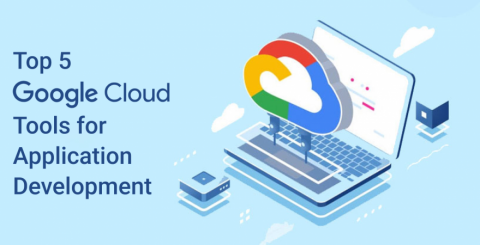Top 5 Google Cloud Tools for Application Development

Google Cloud is one of the market leaders in Cloud Computing services in the current market scenario. It competes with other Cloud Computing market leaders AWS and Microsoft Azure.
In this era of Cloud Computing, Google Cloud Platform offers cost-efficient, reliable, and secure Cloud Computing services to help companies to access their data and information in a better way.
However, Google Cloud Platform offers some amazing Cloud tools for developers to develop amazing Cloud applications that can help companies to manage their information and data more efficiently. These tools not only help companies to create, manage and deploy applications but also help them do the work without any hazards.
In this article, we will mention the top 5 Google Cloud tools for application development purposes that every Google Cloud development company should offer, as all these tools come with outstanding benefits that can help companies to grow.
1. Google Cloud Deployment Manager
Google Cloud Deployment Manager is one of the most efficient tools that you can use for Google Cloud application development purposes. It simplifies cloud management in a cost-efficient way. This highly advanced tool automates the creation and management of Google Cloud Platform resources, including computing, storage, networking and databases.
It allows users to write flexible templates and configuration files. Also, users can use these files and templates to create deployments along with a range of Google Cloud services, including cloud storage, cloud SQL, compute engine, etc. All these services are configured to work together to offer a convenient working experience to the developers.
It is an IaC tool of Google that creates the foundation as repeatable code. The tool can precisely utilize around three record types for every Google Cloud platform sending
- Arrangement Document in YAML
- Outline document
- Layout record in Python or Jinja.
At present, this tool doesn't cater to all Google Cloud devices and administrations, but it still works with the vast majority of centric Google contributions. However, one should remember that standard charges might get applied for any related administrations it sends.
2. Google Cloud Anthos
In short, it is a cloud-centric container platform that helps developers to run modern applications anywhere with a consistent scale.
It offers a hybrid container environment that allows users to use container clusters instead of cloud virtual machines (VMs) to fill the gaps between legacy software and cloud hardware. This tool also allows developers to use cloud technology, such as containers and Kubernetes clusters, on existing internal hardware without sacrificing the amazing benefits of cloud services.
It is one of the great tools of Google Cloud Platform as it gives companies a choice to deploy applications and migrate workloads between environments so that one can choose according to the requirements and preferences without compromising other benefits. This platform is primarily developed for enterprise use purposes so that they can manage and coordinate on-premises and cloud workloads. It is one of the most efficient container-container-as-a-service platforms that you can go for.
Remember that Google Cloud Anthos can only run on servers that can efficiently host Kubernetes clusters with the Google Kubernetes Engine. The features of this tool include monitoring, service management, a networking environment, Istio Service Mesh, centralized configuration management, consolidated logging, etc.
3. Google Access Transparency
Google Access Transparency logs help users to learn much more than Cloud audit logs. In short, this tool is representative of Google's long-term commitment to user satisfaction and user trust. Access Transparency logs record the actions that Google personnel take when accessing customer content. So, if you want to know about the actions, you can get the information with these logs that you will not get from Cloud audit logs. It offers increased transparency in data accessibility.
It enables the verification of cloud provider access. Access transparency has become a great matter of concern for cloud computing service users. This particular tool deals with that concern in an efficient way. It allows users to know how the cloud supplier handles the fundamental framework that supports their applications.
With this amazing tool, users can also utilize Google's inward logs that are related to their records. However, this specially developed tool works with six other Google administrations, including Compute Engine, Cloud Storage, App Engine, Persistent Disk, Cloud Key Management Service, and Cloud Identity and Access Management. This tool offers both the clients and suppliers a common platform to sort out their requirements and create a win-win situation.
4. Firebase Real-time Database
In short, it is a cloud-hosted NoSQL database that allows users to store and sync data between their users in real-time. With this development tool, data gets stored as JSON and synchronized in real-time to every connected client. This tool helps users to get updated with recent real-time data so that they can act according to the requirements.
It allows data-dependent users to access several features, including huge unstructured databases, fast improvement, etc. This tool is specially developed for portable web application advancements. This tool can be used with iOS, JavaScript SDKs, Android, and REST APIs. However, one should remember that this tool cannot deal with information in various leveled ways, and also, it is not ideal for a huge data load.
5. Google Cloud Firestore
It is one of the best choices to deal with cloud computing complexities. It allows developers to access a greater number of highlights as well as usefulness compared to Firebase. It is also a more suitable option for developing advanced applications as it is utilized for server-side improvement through Java, Python, Node.js, and Go SDKs.
This tool uses records that contain fields that allow developers to get guidance about genuine worth. It is also a NoSQL document database that allows users to store, sync, and query data from mobile and web applications without any hazards at a global scale.
Conclusion
Talking about Google Cloud development services, all of these tools are highly beneficial for cloud-based application development purposes. These tools simplify different dimensions of cloud application development, which allows developers to create, manage and deploy applications without any hazards on the Cloud Computing Platform. I hope this article was helpful to you.
Similar Articles
The education industry is not left behind by the new digital world shift. E-learning has received much consideration with the help of technological factors coupled with the ever-increasing demand for convenience and personalization
Managing a wide range of assets, from IT equipment to digital resources, can be overwhelming without the right tools. Businesses often struggle with asset mismanagement, leading to delays, unexpected costs, and compliance issues.
E-learning has become a quintessential wave through which learners access education in today’s te
Are you tired of keeping up with regulatory requirements and managing risk, which can feel like navigating a labyrinth? Organizations across industries face mounting pressure to maintain compliance while simultaneously driving growth and innovation.
Anyone even vaguely familiar with today's fast-paced digital world would know that e-commerce businesses face intense pressure. Pressure to deliver exceptional customer experiences while also maximizing their profits. To achieve this delicate balance, companies operating in this space must now put the power of technology to work
Intelligent technology-driven solutions are now guiding industries across all sectors. Innovative and disruptive technologies like Artificial Intelligence (AI) and Machine Learning (ML) are driving these changes, which play a crucial role in designing and developing intelligent solutions.
The introduction of Artificial intelligence (AI) healthcare has caused a radical change in the way that medical care is provided. It gains paramount importance when it comes to customised treatment regimens.
Graphical presentation of data and information in visual formats like charts, maps, and graphs is termed data visualization. This method makes complex data more accessible and easily understandable bringing out the trends and patterns from raw data, which can be used to significantly enhance customer experience
Integrating AI into your business app isn't just a matter of staying current; it's about unlocking new dimensions of efficiency, personalization, and customer satisfaction. Among the most groundbreaking AI technologies is ChatGPT, a language model that simulates human conversation with incredible accuracy.









